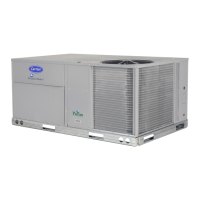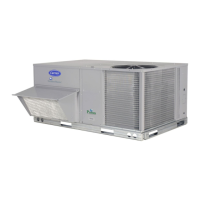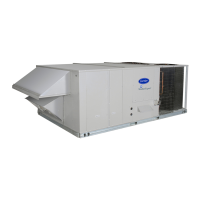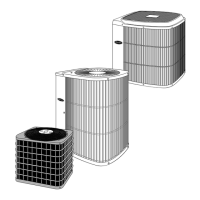2. Measure liquid service valve pressure by attaching an accurate
gage to service port.
3. Measure liquid line temperature by attaching an accurate
thermistor type or electronic thermometer to liquid line near
outdoor coil.
4. Refer to charging label for required subcooling temperatures.
5. Refer to Table 7. Find the point where required subcooling
temperature intersects measured liquid service valve pressure.
6. To obtain required subcooling temperature at a specific liquid
line pressure, add refrigerant if liquid line temperature is
higher than indicated or reclaim refrigerant if temperature is
lower. Allow a tolerance of ± 3°F.
HEATING CHECK CHART PROCEDURE
To check system operation during heating cycle, refer to the
Heating Pump Charging Instructions on outdoor unit. This chart
indicates whether a correct relationship exists between system
operating pressure and air temperature entering indoor and outdoor
units. If pressure and temperature do not match on chart, system
refrigerant charge may not be correct. Do not use chart to adjust
refrigerant charge.
NOTE: In heating mode, check refrigerant charge only when
pressures are stable. If operating conditions cause vapor pressure
switch and thereby outdoor fan to cycle, check refrigerant charge
in cooling or lower indoor dry bulb temperature. If in doubt,
remove charge and weigh in correct refrigerant charge.
NOTE: When charging is necessary during heating season,
charge must be weighed in accordance with unit rating plate ±0.6
oz/ft of 3/8-in. liquid line above or below 15 ft respectively.
EXAMPLE:
To calculate additional charge required for a
25-ft line set:
25 ft - 15 ft = 10 ft X 0.6 oz/ft=6ozof
additional charge
Step 13—System Functions and Sequence of Operation
The outdoor unit control system has special functions. The
following is an overview of the two-speed control functions:
COOLING OPERATION
This product utilizes a 2-stage cooling indoor thermostat. With a
call for first stage cooling (Yl), the outdoor fan and low capacity
compressor are energized. If low capacity cannot satisfy cooling
demand, high capacity is energized (Yl and Y2 or just Y2) by the
second stage of indoor thermostat. After second stage is satisfied,
the unit returns to low-capacity operation until first stage is
satisfied or until second stage is required again. When both one
stage and two stage cooling are satisfied, the compressor will shut
off.
NOTE: Outdoor fan motor will continue to operate for one
minute after compressor shuts off, when outdoor ambient is greater
than 100°F.
NOTE: When two-speed unit is operating in low-capacity cool-
ing, system vapor (suction) pressure will be higher than a standard
single-speed system or high-speed operation. This normal opera-
tion is due to the reduced capacity operating with typically larger
indoor and outdoor coils.
HEATING OPERATION
This product utilizes a 3-stage heating indoor thermostat. With a
call for first stage heating (Y1), the outdoor fan and low capacity
compressor are energized. If low capacity cannot satisfy heating
demand, high capacity is energized (Y1 and Y2) by the second
stage of the indoor thermostat. Auxiliary or back up heat is
controlled by third stage (W1). After second stage of heat is
satisfied, the unit returns to low capacity operation until first stage
is satisfied or until second stage is required again. When both one
stage and two stage heating are satisfied, the compressor will shut
off.
Table 6—Airflow Selection for FK4, FV4, or 40FK Fan Coils (CFM)
38YDB
UNIT
SIZE
40FK/FK4/FV4
UNIT
SIZE
EASY SELECT CONTROL BOARD HEATING CFM
*
COOLING CFM
*
AC/HP
SIZE
(Blue Wire)
AC/HP
CFM ADJUST
(Black Wire)
SYSTEM TYPE
(Orange Wire)
High Low High Low
024
FK4C 001 024 NOM
HP—EFF 735 440
735 440
HP—COMFORT 630 410
002 024 NOM
HP—EFF 735 440
735 440
HP—COMFORT 630 410
003 024 NOM
HP—EFF 735 440
735 440
HP—COMFORT 630 410
036
FK4C 001 036 NOM
HP—EFF 1100 660
1100 660
HP—COMFORT 990 615
002 036 NOM
HP—EFF 1100 660
1100 660
HP—COMFORT 990 615
003 036 NOM
HP—EFF 1100 660
1100 660
HP—COMFORT 990 615
005 036 NOM
HP—EFF 1100 660
1100 660
HP—COMFORT 990 615
006 036 NOM
HP—EFF 1100 660
1100 660
HP—COMFORT 990 670
048
005 048 NOM
HP—EFF 1470 880
1470 880
HP—COMFORT 1320 820
006 048 NOM
HP—EFF 1470 880
1470 880
HP—COMFORT 1325 895
060 006 060 NOM
HP—EFF 1835 1100
1835 1100
HP—COMFORT 1655 1120
* Airflow CFMs are given with AC/HP CFM ADJUST jumper set at NOM. Airflow can be adjusted 15 percent or −10 percent by selecting HI or LO, respectively.
10

